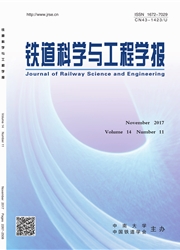

 中文摘要:
中文摘要:
为研究桥面栏杆对桥梁主梁气动特性的影响,分别开展大带东桥主桥加劲梁施工和成桥阶段的CFD模拟,获得不同来流攻角下加劲梁的气动力系数、表面平均压力系数分布和漩涡脱落Strouhal( St )数,并与文献结果进行比较。研究结果表明:栏杆钝化了加劲梁气动特性,局部改变了加劲梁迎风侧压力分布,并使成桥阶段加劲梁阻力系数明显大于施工阶段,0o攻角增大38%。施工和成桥阶段加劲梁均呈现多阶涡脱特征,施工阶段高阶涡脱峰值占优且不受时间步细化的影响;成桥阶段当时间步足够小后可给出峰值占优的低阶涡脱。研究认为,传统CFD模拟忽略桥面附属设施研究成桥气动特性的做法需要改变,必须重视桥面栏杆的抗风设计,重视施工和成桥阶段主梁不同的多阶涡脱特性。
 英文摘要:
英文摘要:
In order to evaluate the effects of deck rails on aerodynamics of bridge girders, CFD simulations were carried out to investigate flow field around girder of the Great Belt East Bridge main span, in both construction stage and in-service stage. The Reynolds-Averaged Navier-Stokes ( RANS) equation and SST k - ωturbulent model were employed,with Reynolds number of 3. 18 × 105 . Aerodynamic coefficients of the girder in two stage were obtained under different wind angles of attack. The mean pressure distribution around the girder surface and vortex-shedding Strouhal (St) number are also obtained. The results agrees well with available wind tunnel tests. It is found that the deck rails would bluff the bridge girder, and change pressure distribution on girder windward side. Compared with construction stage under the same wind angle of attack, the involved deck rails will result in significant increase on drag coefficients, with a maximum increase of 38% at zero angle of attack. Both the con-struction stage and in-service stage indicate a multiple vortex-shedding feature, with high-order vortex shedding dominated regardless of time step refinement in the former. Besides, low-order vortex shedding dominated can be predicted in the later if time step size is small enough. It is found that previous CFD simulations of girder in oper-ation stage without deck rails should be avoided, and aerodynamic design of crash barriers, different vortex-shedding features of girders between the construction stage and operation stage should be put great emphasis.
 同期刊论文项目
同期刊论文项目
 同项目期刊论文
同项目期刊论文
 期刊信息
期刊信息
